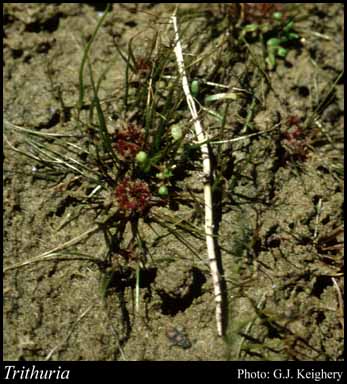- Reference
- Bot.Antarct.Voy.III.(Fl.Tasman.) 2:78 (1859)
- Name Status
- Current

Scientific Description
Family Hydatellaceae.
Sometimes included in Centrolepidaceae.
Habit and leaf form. Aquatic herbs. Glabrous, annual. Leaves basal. Plants very short stemmed, with a basal concentration of leaves. Hydrophytic to helophytic; rooted. Leaves submerged and emergent; alternate; spiral; sessile; shortly sheathing to non-sheathing. Leaf sheaths if detectable, not tubular; with free margins. Leaves simple. Leaf blades entire; flat; linear; linear (to filiform); one-veined, or parallel-veined. Leaves eligulate. Leaf blade margins entire. Leaves presumably with a persistent basal meristem, and basipetal development. Vegetative anatomy. Plants without silica bodies. Leaf anatomy. Hairs absent. Extra-floral nectaries absent. Stem anatomy. Secondary thickening absent.
Reproductive type, pollination. Fertile flowers functionally male, or functionally female. Unisexual flowers present. Plants monoecious (but the heads mixed, by contrast with Hydatella). The unisexual flowers not conspicuously in separate aggregates. Female flowers without staminodes. Male flowers without pistillodes. Floral nectaries absent. Autogamous, or pollinated by water.
Inflorescence and flower features. Flowers aggregated in ‘inflorescences’; in heads; more or less in ‘spikelets’. Inflorescences usually more or less scapiflorous (scapose to sessile); terminal; in aggregate resembling a single flower, but actually comprising numerous capitula each containing 1–5 male flowers or 5–25 female flowers; with involucral bracts (these opposite, membranous, glabrous, 1-veined); pseudanthial. Flowers 2–8 bracteate (the bracts ovate to lanceolate, erect or spreading, translucent, never sheathing); ebracteolate; minute, or small; 1 merous. Hypogynous disk absent. Perianth absent. Fertile stamens present, or absent (female flowers). Androecial members definite in number. Androecium 1 (i.e. the male flower consisting of a single stamen). Androecium exclusively of fertile stamens. Stamens 1. Anthers basifixed; non-versatile; dehiscing via longitudinal slits; bilocular; tetrasporangiate. Fertile gynoecium present, or absent (male flowers). Gynoecium ostensibly 1 carpelled. The pistil 1 celled. Gynoecium monomerous, or syncarpous (perhaps pseudomonomerous, depending on interpretation); of one carpel, or eu-syncarpous; superior. Carpel if considered monomerous, non-stylate; 1 ovuled. Placentation apical. Ovary if considered pseudomonomerous, unilocular; 1 locular; shortly stipitate. Gynoecium non-stylate (if a tuft of filamentous structures represents stigmas), or stylate (if it is stylar). Styles free; apical. Stigmas usually with 3 stigmatic hairs. Placentation apical. Ovules pendulous; non-arillate; anatropous.
Fruit and seed features. Fruit non-fleshy. The fruiting carpel if considered monomerous, dehiscent; a follicle. Fruit if considered syncarpous, dehiscent; a capsule. Capsules three valvular. Fruit 1 seeded. Seeds ‘almost’ non-endospermic. Perisperm present (starchy). Embryo rudimentary at the time of seed release. Testa operculate.
Geography, cytology, number of species. World distribution: Western Australia, Tasmania, New Zealand.
Etymology. From the Greek for "three" and "a little door"; refers to the three valves of the fruit.